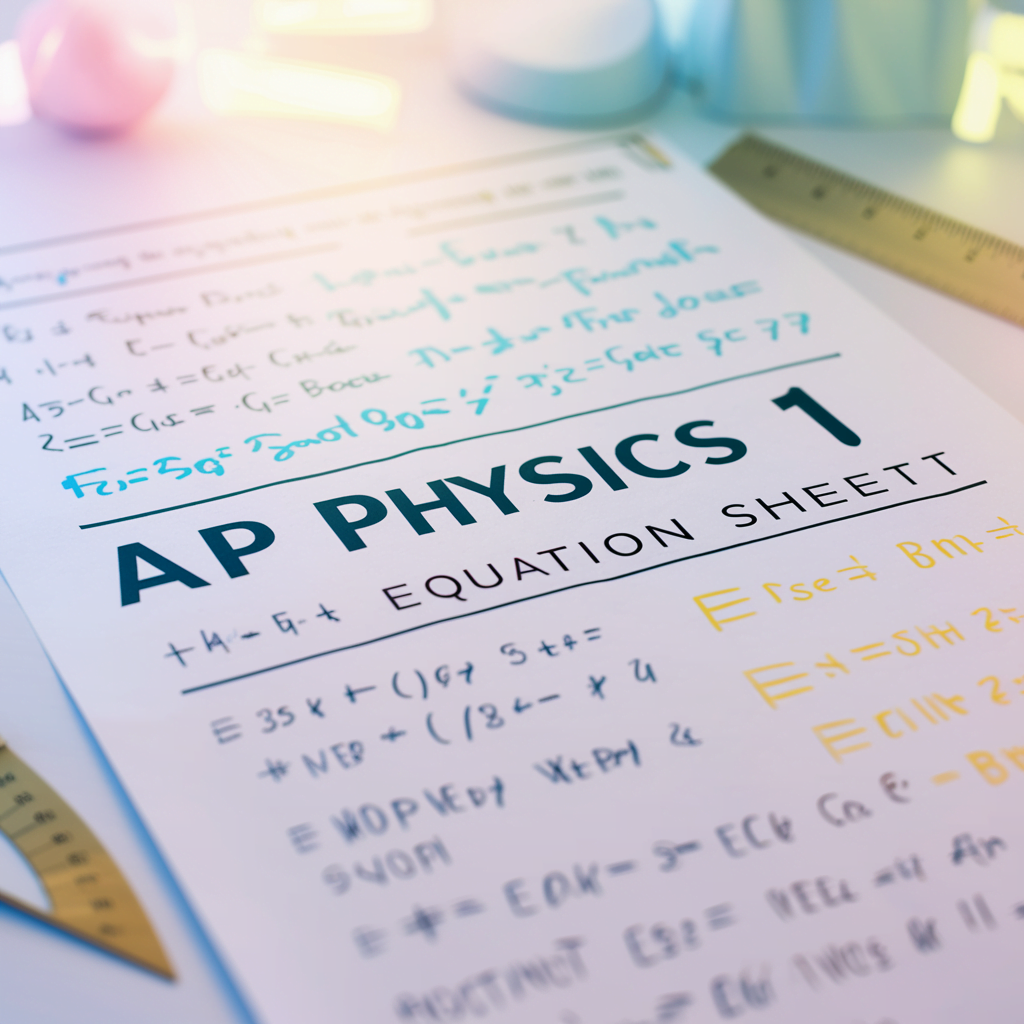- I. Introduction
- A. Understanding the AP Physics 1 Equation Sheet
- B. Navigating the Equation Sheet
- II. Key Concepts and Equations
- III. Problem-Solving Strategies: There's More Than Just Memorising Formulas
- IV. Advanced Tips and Tricks
- Conclusion
- Frequently Asked Questions (FAQs)
I. Introduction
A. Understanding the AP Physics 1 Equation Sheet
The AP Physics 1 Equation Sheet is more than just a collection of formulas—it’s a powerful tool designed to aid you during your exam. This sheet provides a quick reference to the essential equations and constants you’ll need to solve problems, saving your valuable time and helping ensure accuracy under pressure.
Why is it important? The equation sheet allows you to focus on applying concepts rather than memorising formulas. This means you can spend more time understanding the problems and less time worrying about recalling every equation. In essence, it’s your trusty sidekick, always ready to assist when you’re navigating through the challenging terrain of physics questions.
B. Navigating the Equation Sheet
Navigating the AP Physics 1 Equation Sheet efficiently can greatly enhance your performance on the exam. Here are some strategies to help you make the most of this valuable resource:
-
Familiarise Yourself with the Layout:
- Spend time reviewing the equation sheet before the exam to understand its structure.
- Note how the equations are grouped by topic, such as mechanics, electricity, and magnetism.
- Identify where key constants and units are located.
-
Highlight Key Sections:
- Use coloured markers or tabs to highlight different sections. For example, use one colour for mechanics and another for electricity.
- This visual differentiation can help you quickly locate the section you need during the exam.
-
Understand the Symbols:
- Make sure you understand the symbols and variables used in the equations. For example,
 stands for velocity,
stands for velocity,  for acceleration, and
for acceleration, and  for force.
for force. - Create a legend if necessary to keep track of these symbols.
-
Practice with the Sheet:
- Use the equation sheet while practising problems to become comfortable with it.
- This will help you become adept at quickly finding and applying the correct equations during the actual exam.
-
Use the Sheet Strategically:
- During the exam, quickly scan the problem to identify which topic it falls under (e.g., kinematics, dynamics).
- Go directly to that section of the sheet and find the relevant equations.
- Write down the equations on your answer sheet before plugging in the numbers. This ensures you have the correct formula and helps avoid mistakes.
-
Check Units and Constants:
- The equation sheet includes important constants like the gravitational constant (
 ) and Coulomb’s constant (
) and Coulomb’s constant (  ).
). - Always ensure that the units you use in your calculations match those in the equation sheet to avoid errors.
By following these strategies, you can navigate the AP Physics 1 Equation Sheet with ease and confidence, ensuring you make the most of this valuable resource during your exam.
To know more about the AP Physics 1 FRQs, click here.
II. Key Concepts and Equations
A. Kinematics: The Equations of Motion
-
Constant Acceleration:
-
 : Equation for displacement with constant acceleration.
: Equation for displacement with constant acceleration.
-
 : Equation for final velocity with constant acceleration.
: Equation for final velocity with constant acceleration.
-
 : Equation for final velocity squared with constant acceleration.
: Equation for final velocity squared with constant acceleration.
-
Motion with Varying Acceleration:
-
 : Equation for velocity as a function of time.
: Equation for velocity as a function of time.
-
 : Equation for displacement over an interval of time with varying acceleration.
: Equation for displacement over an interval of time with varying acceleration.
-
Projectile Motion:
-
 : Equation for horizontal displacement in projectile motion.
: Equation for horizontal displacement in projectile motion.
-
 : Equation for vertical displacement in projectile motion.
: Equation for vertical displacement in projectile motion.
B. Forces and Dynamics
-
Newton’s Laws of Motion:
-
 : Newton’s second law of motion.
: Newton’s second law of motion.
-
 : Equation for net force and change in momentum.
: Equation for net force and change in momentum.
-
 : Equation for work done by a force.
: Equation for work done by a force.
-
Momentum and Impulse:
-
 : Equation for momentum.
: Equation for momentum.
-
 : Equation for impulse.
: Equation for impulse.
-
Work and Energy:
-
 : Equation for work done and change in kinetic energy.
: Equation for work done and change in kinetic energy.
-
 : Equation for work done by the net force and change in potential energy.
: Equation for work done by the net force and change in potential energy.
C. Circular Motion and Rotation
-
Circular Motion:
-
 : Equation for angular displacement.
: Equation for angular displacement.
-
 : Equation for angular velocity.
: Equation for angular velocity.
-
Kinematics and Dynamics of Rotation:
-
 : Equation for torque and angular acceleration.
: Equation for torque and angular acceleration.
D. Simple Harmonic Motion
-
Understanding Simple Harmonic Motion:
-
 : Equation for displacement in simple harmonic motion.
: Equation for displacement in simple harmonic motion.
-
 : Equation for velocity in simple harmonic motion.
: Equation for velocity in simple harmonic motion.
-
Analysing Springs and Pendulums:
-
 : Equation for the period of a simple harmonic oscillator.
: Equation for the period of a simple harmonic oscillator.
E. Topics Not Rrelevant to AP Physics 1 Exam
While preparing for the AP Physics 1 exam, it’s essential to focus on the specific topics within the exam’s scope. There are several high school physics topics that are not covered in this exam. Understanding which topics to exclude can help streamline your study process and ensure you concentrate on the material that matters most.
1. Thermodynamics
- Explanation: Thermodynamics deals with heat, work, and the laws governing the conversion of energy from one form to another.
- Irrelevance: The AP Physics 1 exam does not include questions on thermodynamic processes, the laws of thermodynamics, or related concepts like entropy and enthalpy.
2. Optics
- Explanation: Optics is the study of light, its properties, and its interactions with different materials.
- Irrelevance: Topics such as reflection, refraction, lenses, mirrors, and optical instruments are not part of the AP Physics 1 curriculum.
3. Modern Physics
- Explanation: Modern physics covers advanced concepts including quantum mechanics, relativity, and atomic structure.
- Irrelevance: The AP Physics 1 exam focuses on classical mechanics and does not require an understanding of modern physics topics such as the photoelectric effect, wave-particle duality, or special relativity.
4. Nuclear Physics
- Explanation: Nuclear physics involves the study of atomic nuclei, radioactivity, nuclear reactions, and related applications.
- Irrelevance: Concepts like nuclear decay, fission, fusion, and applications in nuclear energy and medicine are not included in the AP Physics 1 exam.
5. Electromagnetic Induction
- Explanation: This topic covers the generation of electric current through a changing magnetic field and includes Faraday’s Law and Lenz’s Law.
- Irrelevance: While the AP Physics 1 exam includes basic electricity and magnetism, it does not delve into the complexities of electromagnetic induction and related devices like transformers and generators.
6. Thermal Physics
- Explanation: This area includes the study of temperature, heat transfer, and the behavior of gases through concepts like the kinetic theory and heat capacity.
- Irrelevance: Detailed topics in thermal physics, such as the specific heat capacities of substances and the laws governing heat transfer, are beyond the scope of the AP Physics 1 curriculum.
7. Advanced Electricity and Magnetism
- Explanation: This includes more complex topics in electricity and magnetism such as Maxwell’s equations, alternating current (AC) circuits, and advanced electromagnetic theory.
- Irrelevance: The AP Physics 1 exam focuses on fundamental principles of electricity and magnetism, such as Ohm’s law, basic circuit elements, and Coulomb’s law. Advanced topics like Maxwell’s equations and AC circuits are not included.
8. Wave Phenomena Beyond Basics
- Explanation: This includes advanced wave topics such as standing waves, sound intensity, Doppler effect, and interference patterns.
- Irrelevance: While basic wave properties might be touched upon, more advanced wave phenomena are not required for the AP Physics 1 exam.
By focusing your study efforts on the relevant topics for AP Physics 1 and avoiding those that are not included, you can prepare more effectively and efficiently for the exam. Concentrate on mastering mechanics, electricity and magnetism, waves and sound, and simple harmonic motion to ensure you are well-prepared
III. Problem-Solving Strategies: There’s More Than Just Memorising Formulas
A. Finding the Right Tool for the Job: Matching Equations to Problems
When faced with a physics problem during AP Physics 1 exam day , the first step is to determine which equations are relevant. This involves:
- Reading the problem carefully: Identify the quantities given and what you need to find.
- Categorising the problem: Determine if it relates to kinematics, dynamics, circular motion, simple harmonic motion, or electricity and magnetism.
- Selecting the right equations: Use your knowledge of physics principles to choose the equations that connect the given information to the unknowns.
B. Setting Up Your Solution: Variables and Units
Properly setting up your problem is crucial:
- Define all variables: Clearly state what each symbol represents (e.g.,
 for initial velocity,
for initial velocity, for acceleration).
for acceleration). - Interpret units: Make sure all quantities are in compatible units. Convert units if necessary.
- Maintain consistency: Use consistent units throughout the problem to avoid calculation errors.
C. Putting It All Together : Step by Step Solutions:
Let’s look at how to apply these strategies to different types of AP Physics 1 problems using the equation sheet.
-
Kinematics Problems: Putting Motion Equations into Practice
Example: A car accelerates from ![]() to
to ![]() over
over ![]() . Find the acceleration and the distance travelled.
. Find the acceleration and the distance travelled.
Solution:
- Identify knowns:
 ,
,  ,
,  .
. - Use
 :
:
- Use
 :
:
 .
.
-
Force and Dynamics Problems: Applying Newton’s Laws with Equations
Example: A ![]() box is pushed with a
box is pushed with a ![]() force on a surface with a friction coefficient of
force on a surface with a friction coefficient of ![]() . Find the acceleration of the box.
. Find the acceleration of the box.
Solution:
- Identify known:
 ,
, ,
, .
. - Calculate the frictional force:
 .
. - Determine the net force:
 .
. - Use
 :
:  .
. - Solve for
 :
:  .
.
-
Circular Motion and Rotational Motion Problems: Analysing Curved Paths
Example: A ![]() ball attached to a
ball attached to a ![]() string is whirled in a horizontal circle at
string is whirled in a horizontal circle at ![]() . Find the tension in the string.
. Find the tension in the string.
Solution:
- Identify knowns:
 ,
,  ,
,  .
. - Use
 :
:  .
. - Determine the tension using
 :
:  .
.
-
Simple Harmonic Motion Problems: Solving for Oscillations
Example: A mass-spring system oscillates with a spring constant ![]() and a mass
and a mass ![]() . Find the period of oscillation.
. Find the period of oscillation.
Solution:
- Identify knowns:
 ,
,  .
. - Use
 :
:  .
.
D. Double-Checking Your Work: Making Sure Your Answers Are Right
After solving the problem, it’s crucial to verify your answer:
- Check units: Ensure that your final answer has the correct units.
- Recalculate key steps: Go through your calculations again to spot any arithmetic errors.
- Assess reasonableness: Consider whether the answer makes sense physically (e.g., no negative distances or impossible speeds).
- Cross-reference: Compare your answer with related principles or equations to ensure consistency.
By following these strategies, you can approach and solve physics problems methodically, enhancing both your understanding and performance on the AP Physics 1 exam. For the further reading you can explore our blog on How to study for AP Physics 1.
IV. Advanced Tips and Tricks
A. Going Deeper: Understanding the Why Behind the Equations
To excel in AP Physics 1, it’s crucial to move beyond merely memorising equations and understand the underlying concepts. This deeper comprehension allows you to apply equations more effectively and adapt to unfamiliar problems. Here’s how to get there:
Conceptual Framework: Learn the physical principles behind each equation. For example, Newton’s second law
![]()
isn’t just a formula but a principle that describes how forces affect motion.
Derivations: Study the derivations of key equations. Understanding how an equation is derived helps you grasp its limitations and applications. For instance, knowing how ![]() is derived from the definitions of velocity and acceleration solidifies your understanding of kinematics.
is derived from the definitions of velocity and acceleration solidifies your understanding of kinematics.
Visualise: Use diagrams and graphs to visualise problems. Sketching free-body diagrams for forces or motion graphs for kinematics can make the relationships between variables clearer.
B. Tech time : Using calculator and online resources
Leverage technology to enhance your problem-solving skills:
Calculators: Master your scientific calculator. Know how to quickly input equations, use memory functions, and perform complex calculations. Practice using your calculator under timed conditions to simulate exam scenarios.
Key Functions: Ensure you are comfortable with functions like solving quadratic equations, using trigonometric functions, and performing statistical calculations, which are often required in physics problems.
Online Simulations and Visualisations: Utilise online tools such as PhET Interactive Simulations to see physics principles in action. These resources can help you understand complex concepts through interactive visualisations.
Educational Videos and Tutorials: Websites like Tutoringmaphy , Khan Academy and YouTube offer countless tutorials that can provide different perspectives and explanations for difficult topics. Watching these can reinforce your understanding and offer new ways to approach problems.
C. Building Confidence: Practice is the Key
Past Papers: Work through past exam papers and familiarise yourself with the format and types of questions asked. This will help you get used to the timing and pressure of the actual exam.
Practice Problems: Use textbooks and online resources to find additional problems. The more diverse the problems you solve, the more versatile and prepared you’ll become.
Timed Practice: Simulate exam conditions by timing yourself while solving problems. This will help you manage your time effectively during the actual exam.
Review Mistakes: Go over your incorrect answers to understand where you went wrong. This will help you identify and address your weak areas.
Study Groups: Join or form study groups to discuss and solve problems collaboratively. Explaining concepts to peers is a great way to reinforce your own understanding.
By integrating these advanced tips and tricks into your study routine, you can develop a deeper understanding of physics concepts, make efficient use of technology, and build the confidence needed to excel in AP Physics 1.
Conclusion
Mastering the AP Physics 1 equation sheet is crucial for exam success. It’s more than a list of formulas; it’s a tool for quickly finding and applying equations, saving time and increasing accuracy. Familiarity with the sheet reduces the need for memorization, allowing you to focus on problem-solving and better time management, leading to higher scores. Regular practice ensures you’re well-prepared for the exam.
Beyond the exam, the equation sheet benefits future physics studies and STEM fields. The principles and equations form the basis for advanced courses like electromagnetism and quantum mechanics, enhancing analytical and critical thinking skills valuable in academics and careers. Mastering these concepts provides a strong foundation for future pursuits.
In conclusion, mastering the AP Physics 1 equation sheet boosts your exam performance and lays a foundation for future success. Embrace the challenge, practice diligently, and use the sheet as your guide to success.
Frequently Asked Questions (FAQs)
Q. Which Equations Are Given on the AP Physics 1 Test?
Great news for those of us who aren’t maths whizzes but still love the thrill of physics: the AP Physics 1 exam does provide an equation sheet! This sheet includes a list of equations and constants that are frequently used in the exam. While you get a handy reference guide, it’s still essential to understand when and how to use these equations. After all, the test is more about applying concepts than just plugging in numbers.
The provided equation sheet typically includes:
- Kinematics equations
- Newton’s laws and related formulas
- Work, energy, and power equations
- Momentum and impulse equations
- Circular motion and gravitation formulas
- Simple harmonic motion equations
- Electrostatics
A list of physical constants (like ![]() and
and ![]() )
)
Q. Do We Get an Equation Sheet in AP Physics 1?
Absolutely! When you sit down to take the AP Physics 1 exam, you’ll be provided with an equation sheet. It’s like having a mini cheat sheet, but legally! This sheet is your best friend during the test, offering a quick reference to those crucial formulas you need to solve the problems.
However, don’t rely solely on the sheet. Practice is key. Familiarise yourself with the equations and understand their applications so that when you see a problem, you know which equation to reach for and how to manipulate it to find the solution. Think of the equation sheet as a trusty sidekick; you’re Batman, and it’s your Robin. Together, you’ll tackle the villains of physics problems!



